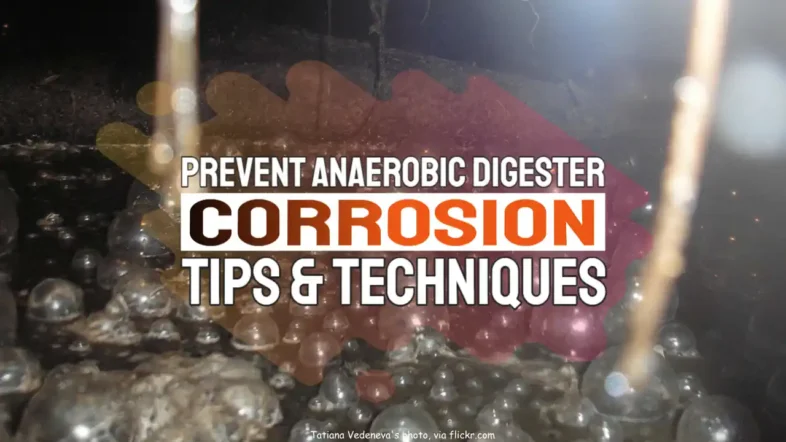Anaerobic digester corrosion is a major challenge. It's mostly caused by the highly corrosive hydrogen sulfide (H₂S) and volatile organic acids (VOCs) produced during anaerobic digestion. This corrosion affects the tank's walls, undersides, and pipework, particularly in the vapour space above the liquid.
To combat this, protective coatings (like epoxy and polyurethane), high-performance linings, and corrosion-resistant materials such as stainless steel are used to extend the equipment's lifespan and prevent costly failures.
Anaerobic Digester Corrosion – Key Takeaways
- Hydrogen sulfide (H₂S) is the primary cause of anaerobic digester corrosion, creating highly corrosive sulfuric acid when combined with moisture.
- The gas headspace and liquid-gas interface are the most vulnerable areas for corrosion, requiring specialised protection strategies.
- Proper material selection, including glass-lined steel and specialised epoxy coatings, can significantly extend digester lifespan.
- Chemical treatments using iron salts and pH control methods effectively bind with sulfides and minimise H₂S production.
- Belzona provides innovative polymeric solutions specifically designed to combat the harsh corrosive environments in anaerobic digesters.
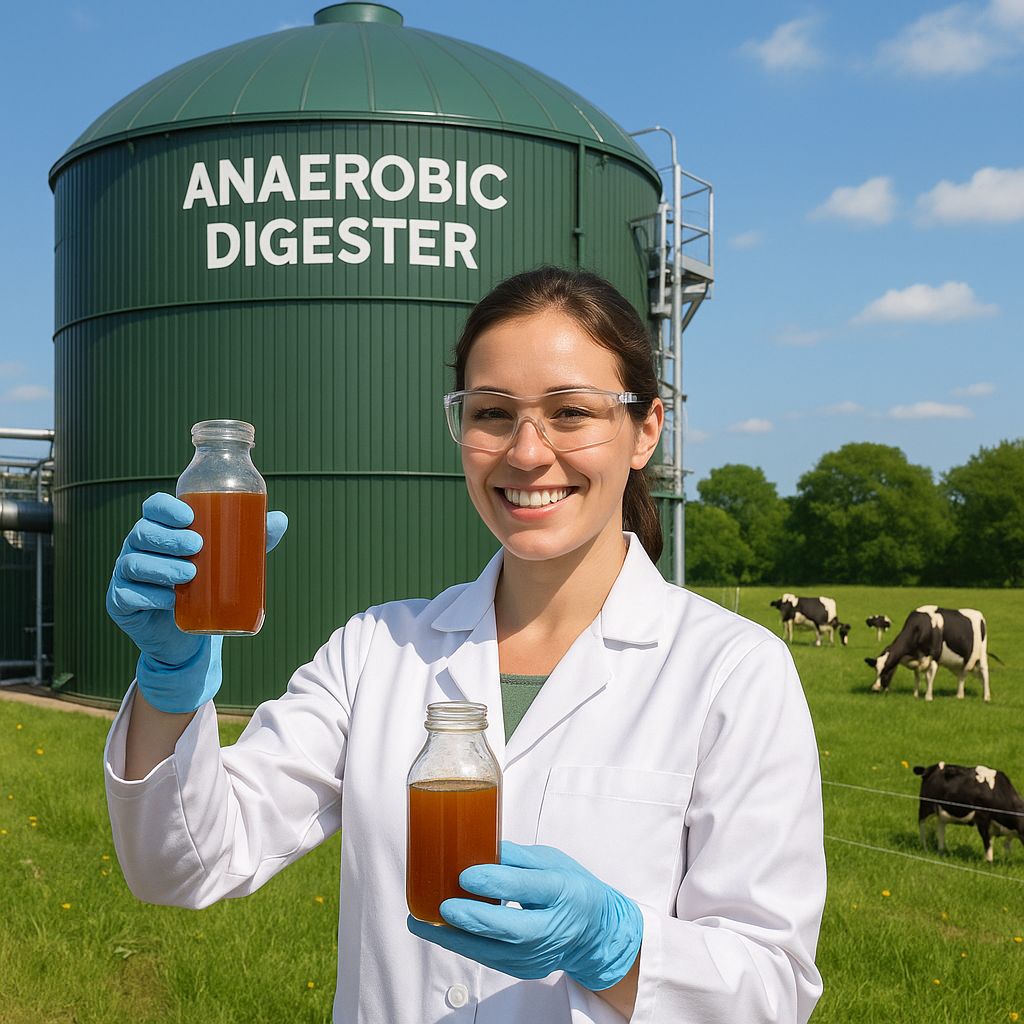
Dangerous Hydrogen Sulfide: The Main Culprit Behind Digester Corrosion
Anaerobic digesters face a relentless enemy: corrosion. At the heart of this destructive process is hydrogen sulfide (H₂S), a gas produced during the anaerobic digestion process. When H₂S combines with moisture in the digester environment, it creates highly corrosive sulfuric acid that aggressively attacks both metal and concrete surfaces. This chemical assault can dramatically shorten equipment lifespan, increase maintenance costs, and even lead to catastrophic failures if left unchecked.
The fermentation processes in biogas plants create perfect conditions for corrosion at both gas and liquid phases. A Southern California sewage treatment plant experienced this firsthand, suffering severe corrosion in the vapour space at the top of its digester tank. The corrosive environment in digesters is particularly insidious because it attacks from multiple angles—the headspace gas, the liquid-gas interface, and even beneath the waterline.
Understanding this corrosion mechanism is crucial for implementing effective prevention strategies. H₂S concentrations as low as a few parts per million can initiate corrosion processes, while higher concentrations accelerate degradation exponentially.
The gas is heavier than air, meaning it tends to accumulate in pockets and create localised corrosion hotspots. Additionally, temperature fluctuations in digesters can exacerbate the problem by creating condensation that amplifies the corrosive effects of H₂S.
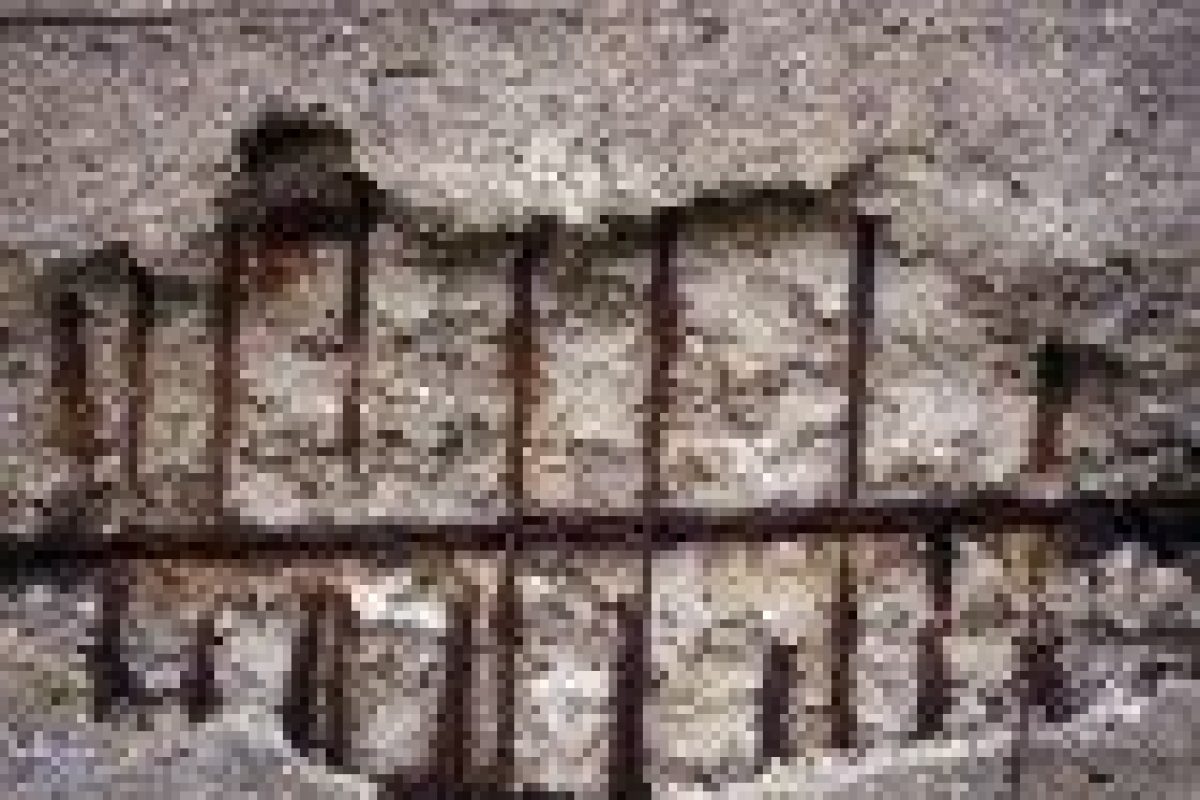
“Hydrogen Sulfide in Your Septic Tank …” from www.aero-stream.com and used with no modifications.
5 Critical Areas Most Vulnerable to Anaerobic Digester Corrosion
Knowing where corrosion strikes most aggressively allows for targeted prevention strategies. Anaerobic digesters experience varying degrees of corrosion across their structure, with some areas requiring significantly more attention than others.
By focusing protection efforts on these critical zones, operators can maximise both effectiveness and resource efficiency in their maintenance programs. Learn more about the importance of anaerobic digestion plants and their maintenance..
1. Gas Headspace: Why It's the Most Susceptible Zone
The gas headspace represents the most vulnerable area in any anaerobic digester system. This zone contains the highest concentration of H₂S gas, which combines with condensation on upper surfaces to form sulfuric acid. The repeated wetting and drying cycles in this area create particularly aggressive corrosion conditions. Equipment mounted in the headspace, such as monitoring instruments, mixing equipment, and gas handling components, often shows the first signs of deterioration. Regular inspection of these components using mirrors, cameras, or during scheduled maintenance shutdowns provides early warning of developing corrosion issues.
For example, the installation of systems like Landia's GasMix System can enhance the efficiency and longevity of anaerobic digestion plants.

Tatiana Vedeneva's photo, licensed as CC BY-NC 2.0 Via flickr.com
2. Liquid-Gas Interface: The Perfect Storm for Deterioration
The boundary where liquid meets gas creates a uniquely destructive environment. This interface experiences constant fluctuation as digester contents rise and fall, exposing surfaces to alternating wet and dry conditions.
Corrosion at this level often appears as a distinct horizontal line of deterioration around the interior circumference of the tank. The interface area experiences the combined effects of both liquid-phase and gas-phase corrosion mechanisms, making it particularly challenging to protect.
Concrete digesters show characteristic deterioration at this zone, with visible erosion of the cement matrix and exposed aggregate. In steel digesters, the interface often reveals pitting, crevice corrosion, and loss of protective coatings.
Specialised coating systems designed specifically for this transition zone provide the best protection, with some advanced systems incorporating multiple layers with different properties to address both environments. For more on this topic, check out this article on corrosion management of anaerobic digesters.
- Fluctuating liquid levels create wet/dry cycles that accelerate corrosion
- Both acidic attack and microbially influenced corrosion occur simultaneously
- Traditional coatings often fail at this boundary due to different expansion rates
- Specialised transition zone coatings provide the most effective protection
- Regular monitoring of wall thickness at this level gives early warning of problems
![]()
“Hydrogen sulphide management in …” from www.sciencedirect.com and used with no modifications.
3. Internal Piping and Valves
Internal piping systems face a double threat from both the corrosive environment and the abrasive nature of the sludge being transported. These components typically experience accelerated wear at elbows, reducers, and valve bodies where flow patterns change.
The combination of chemical attack and physical erosion can quickly compromise even robust materials. Specialised coatings that offer both chemical resistance and abrasion protection provide the most effective defence for these critical system components. For more information on managing corrosion in anaerobic digesters, visit this article.
4. Concrete Deterioration Below the Waterline
Concrete digesters face unique challenges below the waterline, where the alkaline concrete encounters acidic digestate. This chemical mismatch leads to gradual deterioration of the concrete matrix, reducing structural integrity over time.
In new digesters, this process can accelerate during cold starts before beneficial bacteria establish a proper pH balance. Concrete deterioration typically manifests as roughening surfaces, exposed aggregate, and, in severe cases, visible reinforcement bars.
Microbiologically influenced corrosion (MIC)
Microbiologically influenced corrosion (MIC) compounds the problem as acid-producing bacteria colonise porous concrete surfaces. These microorganisms create localised pockets of highly acidic conditions that accelerate concrete degradation far beyond what would occur from simple chemical exposure.
Specialised concrete additives and protective linings help mitigate these effects, with modern polymer-modified cementitious coatings offering excellent chemical resistance while maintaining structural compatibility with the underlying concrete. For more insights, explore how anaerobic digestion plants manage similar challenges.
5. Metal Components and Mixers
Submerged metal components face relentless corrosive attack, particularly at weld seams and stress points. Mixers and agitators are especially vulnerable due to their constant motion and the additional stress of mechanical operation.
The combination of chemical attack, abrasion from particulates, and mechanical stress creates ideal conditions for accelerated corrosion. Galvanic corrosion becomes a significant concern when different metals come into contact within the electrolyte-rich environment of the digester contents.
Material selection is critical
Careful material selection is critical for these components, with duplex stainless steels and specialised alloys offering superior performance in many applications.
Sacrificial anodes and impressed current systems can provide additional protection for metal components that cannot be easily coated or replaced.
Regular inspection of these components is essential, as failure can lead to not only corrosion issues but also operational problems with mixing efficiency and solids handling.
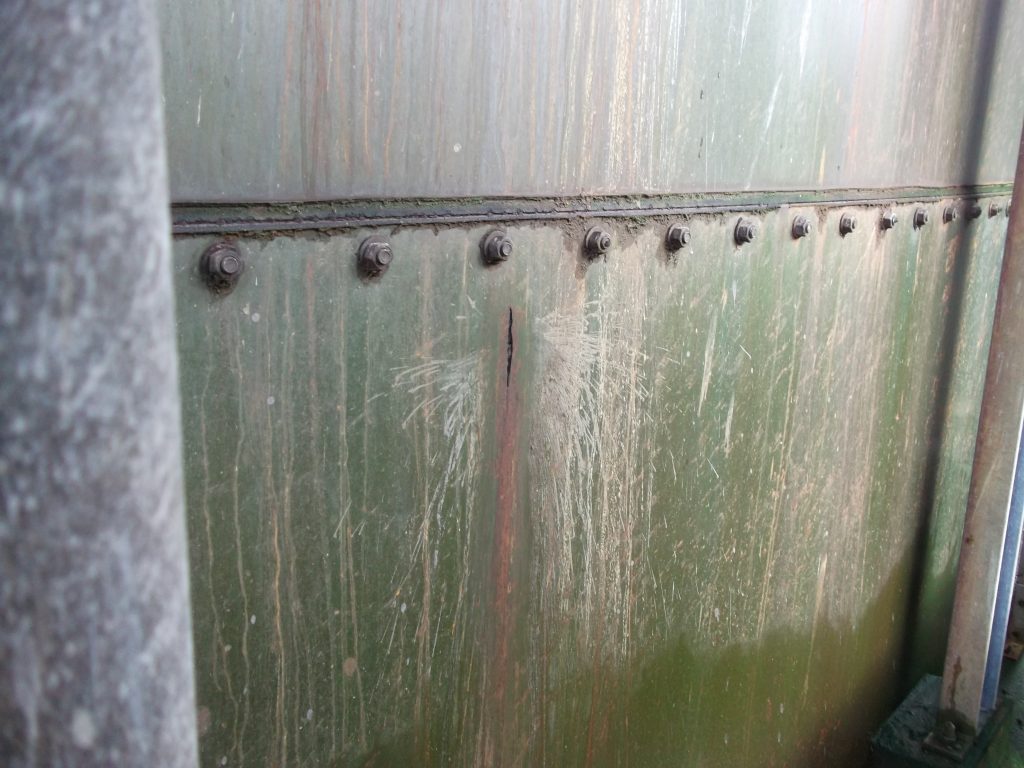
“Anaerobic Digester Corrosion Maintenance” from blog.belzona.com and used with no modifications.
Material Selection: Your First Line of Defence
Choosing the right materials for anaerobic digesters represents the most fundamental corrosion prevention strategy.
The harsh operating environment demands materials that can withstand both chemical attack and the physical stresses of daily operation. While initial construction costs may increase with premium materials, the long-term savings in maintenance, downtime, and equipment longevity typically justify the investment.
A comprehensive material selection strategy considers not only immediate performance but also long-term degradation patterns and maintenance accessibility.
The effectiveness of different materials varies significantly depending on their specific application within the digester system. What works perfectly in one area may fail prematurely in another due to different exposure conditions. A well-designed system often incorporates multiple materials, each optimised for its specific environment and function within the overall structure.
Glass-Lined Steel: Benefits and Limitations
Glass-lined steel represents the gold standard for internal digester protection, offering exceptional chemical resistance in both liquid and gas phases. This material consists of a steel substrate with a fused glass coating applied at high temperatures, creating an inert barrier between the aggressive digester environment and the underlying metal.
The glass lining provides outstanding resistance to a wide pH range and excellent protection against microbially influenced corrosion that would rapidly attack unprotected steel.
However, glass linings come with important limitations. Manufacturing defects or installation damage can result in pinholes within the glass surface, creating vulnerability points where aggressive chemicals can attack the underlying steel.
Once corrosion begins at these points, it can spread rapidly beneath the glass lining, eventually causing sections to detach. Mechanical impact during maintenance or from internal equipment can also damage the relatively brittle glass surface.
Despite these limitations, when properly installed and maintained, glass-lined steel remains one of the most effective and durable options for digester construction that will avoid the dangers of anaerobic digester corrosion.
Epoxy Coatings: Application Techniques for Maximum Protection
High-performance epoxy coatings provide excellent corrosion protection when properly selected and applied. These systems typically incorporate multiple layers, including primers formulated for maximum adhesion to the substrate, intermediate coats for build and chemical resistance, and topcoats engineered for specific exposure conditions.
The most effective epoxy systems for digesters incorporate chemical-resistant novolac formulations that withstand the highly acidic conditions created by hydrogen sulfide gas.
Proper surface preparation to prevent anaerobic digester corrosion represents the most critical factor in coating success. Steel surfaces require abrasive blasting to near-white metal (NACE 2/SSPC-SP10 or SA 2.5) to remove all contaminants and create an optimal anchor profile.
Some suggest that concrete surfaces need similar attention, with removal of laitance and creation of an appropriate surface profile through methods like abrasive blasting or high-pressure water jetting.
Temperature and humidity control during application significantly impacts coating performance, with careful monitoring required throughout the curing process.
When these application protocols are followed rigorously, modern epoxy systems can provide 10-15 years of anaerobic digester corrosion protection even in the most aggressive digester environments.
Stainless Steel Grades That Resist Biogenic Corrosion
Standard 304 stainless steel offers inadequate protection in digester environments, with many facilities experiencing premature failure of these components. The higher-performing 316L grade, with its molybdenum content, provides substantially better resistance to the sulfuric acid conditions typical in digesters.
For the most critical applications, duplex stainless steels (such as 2205) offer superior performance by combining excellent corrosion resistance with higher strength and stress corrosion cracking resistance.
In extremely demanding applications, super duplex grades (such as 2507) or specialised alloys containing high nickel content provide the ultimate protection. These premium anaerobic digester corrosion materials maintain their integrity even in the most aggressive conditions but come with significantly higher costs.
The selection of appropriate stainless steel grades should consider not only the chemical environment but also mechanical stresses, temperature fluctuations, and cleaning procedures that might impact long-term performance.
Always consult a qualified expert in order to select the best corrosion-resistant materials.
For more information on related applications, explore anaerobic digestion plants and their use of durable materials.
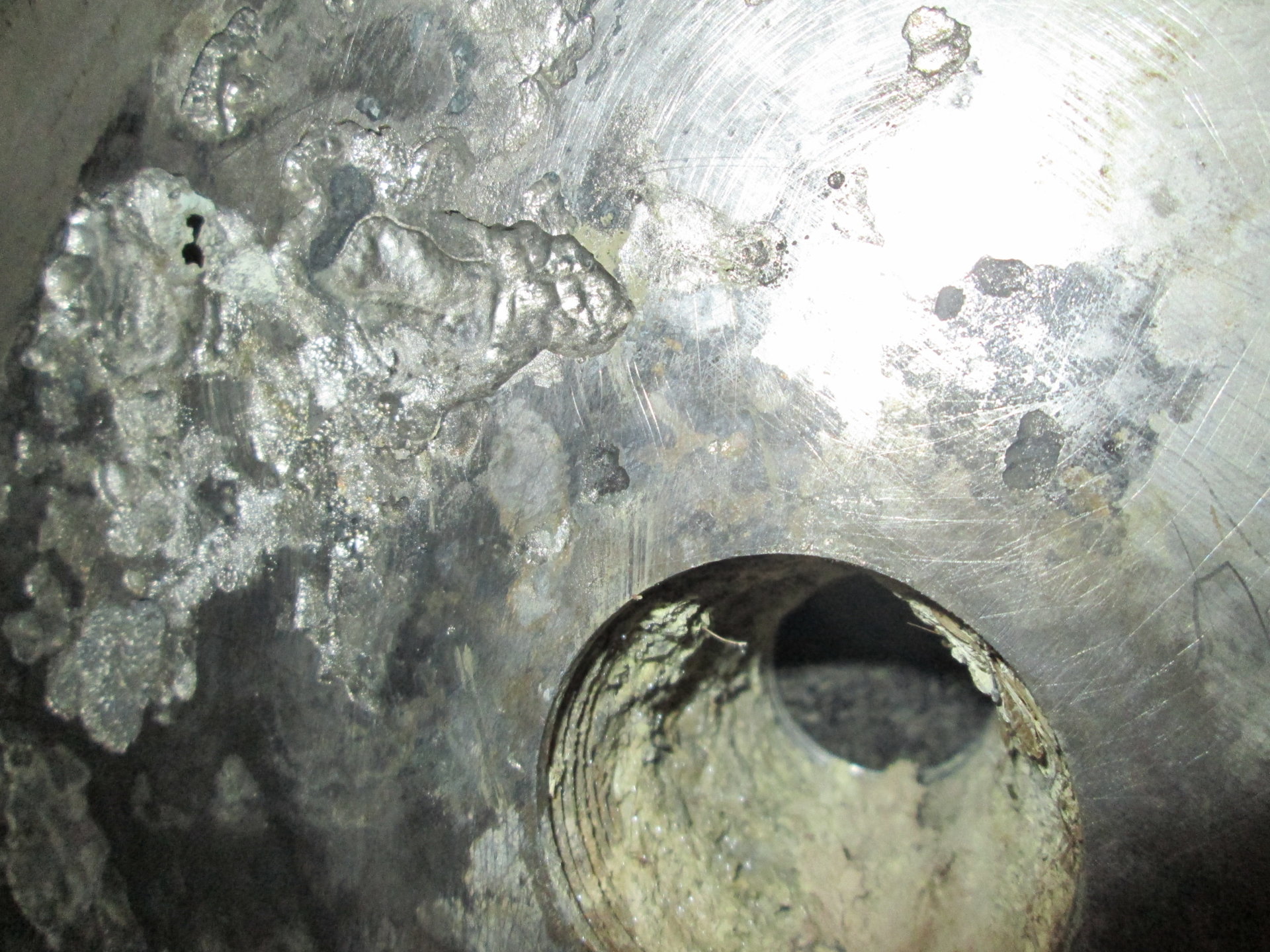
“Digester stainless steel corrosion …” from thefarmingforum.co.uk and used with no modifications.
Chemical Treatment Strategies That Actually Work
While physical barriers provide the primary defence against corrosion, chemical treatment strategies offer powerful complementary protection by addressing the root causes of hydrogen sulfide formation.
These anaerobic digester corrosion avoidance approaches focus on altering the digester chemistry to either prevent H₂S production or neutralise it before it can cause damage. Implementing the right chemical strategy requires understanding both the biological processes driving digestion and the complex chemical interactions occurring within the system.
The most effective chemical treatment programs typically employ multiple strategies simultaneously, creating a layered defence against corrosion. Continuous monitoring and adjustment of chemical dosing ensures optimal performance while avoiding the excessive chemical usage that could potentially disrupt the delicate biological balance within the digester.
Iron Salts: How They Bind with Sulfides
Iron salt addition represents one of the most effective and widely used chemical treatments for controlling hydrogen sulfide in digesters. Ferric chloride (FeCl₃) and ferrous chloride (FeCl₂) both react readily with dissolved sulfides to form insoluble iron sulfide precipitates, effectively removing the precursors to gaseous H₂S.
This precipitation not only reduces anaerobic digester corrosion potential but also improves digestate quality by removing sulfides that could cause odour issues in downstream processing. Dosing typically occurs at the digester inlet, with rates adjusted based on regular monitoring of dissolved sulfide levels and H₂S gas production.
pH Control Methods to Minimise H₂S Production
Strategic pH management significantly impacts hydrogen sulfide release, as H₂S exists primarily in solution at higher pH levels rather than releasing as a gas. Maintaining digester pH between 7.5-8.0 typically provides the optimal balance between effective digestion and sulfide control.
Alkali addition, commonly using sodium hydroxide or sodium bicarbonate, helps maintain this optimal range while buffering against pH fluctuations that could trigger sudden H₂S release.
Careful monitoring prevents excessive alkalinity that could inhibit the anaerobic digestion process, with automated dosing systems providing the most consistent anaerobic digester corrosion control.
Oxygen Injection: When and How to Use It Safely
Micro-aeration through controlled oxygen injection offers a powerful tool for sulfide control in digesters. Small amounts of oxygen (typically less than 1% of biogas volume) create conditions where sulphide-oxidising bacteria convert dissolved sulfides to elemental sulfur before they can form H₂S gas.
This biological approach maintains digester efficiency while significantly reducing corrosion potential. Implementation requires precise control to avoid disrupting the anaerobic conditions necessary for methane production, with oxygen typically injected into the recirculation line or headspace at carefully calculated rates.
Anaerobic Digester Corrosion Case Study: California Wastewater Treatment Facility
A Southern California sewage treatment plant implemented a combined iron salt and micro-aeration system after experiencing severe vapour-space corrosion in its primary digester. The facility installed a ferric chloride dosing system at the digester inlet and a controlled oxygen injection system in the recirculation line.
After six months of operation, H₂S levels in the headspace decreased by 87%, and inspection revealed no new corrosion development in previously vulnerable areas. The facility reported a 92% reduction in corrosion-related maintenance costs during the following year, with full return on investment achieved within 18 months.
Chemical treatment programs require regular reassessment as feedstock characteristics and operational parameters change. Seasonal variations in organic loading and temperature can significantly impact sulfide production, necessitating corresponding adjustments to chemical dosing.
Documentation of treatment effectiveness through regular monitoring creates valuable historical data that informs long-term optimisation of the corrosion prevention strategy.
While chemical treatments significantly reduce corrosion potential, they work best as part of a comprehensive strategy that includes proper material selection and protective coatings.
The synergistic effect of these combined approaches provides far greater protection than any single method alone. Facility operators report the greatest success when implementing integrated protection strategies tailored to their specific operating conditions and digester design.
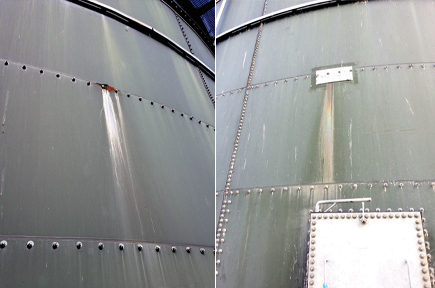
“Anaerobic Digesters and Sludge Tanks …” from biomassmagazine.com and used with no modifications
Monitoring Systems: Catch Problems Before They Start
Effective anaerobic digestion corrosion monitoring provides the cornerstone of any successful corrosion prevention strategy. By detecting problems in their earliest stages, facility operators can address issues before they develop into costly failures.
Modern monitoring approaches combine traditional inspection techniques with advanced technologies to create comprehensive surveillance systems that provide both immediate alerts and long-term trending data for strategic planning.
For more information on how advanced mixing systems are being implemented, check out Landia's GasMix system at Cory's first anaerobic digestion plant.
H₂S Gas Detectors: Placement and Maintenance
Strategic placement of hydrogen sulphide detectors throughout the digester system provides critical real-time data on corrosion potential. Fixed monitoring systems should target known anaerobic digestion corrosion trouble spots, including the digester headspace, gas handling equipment, and enclosed areas where gas might accumulate.
These systems require regular calibration, typically quarterly, to maintain accuracy in the harsh digester environment. Many facilities now implement wireless monitoring networks that transmit continuous readings to centralised control systems, allowing for immediate response to rising H₂S levels before they reach critical thresholds.
Corrosion Coupons: Your Early Warning System
Corrosion “coupons” can provide invaluable data on actual metal loss rates within the digester environment. These pre-weighed metal specimens may be installed in representative locations throughout the system and periodically removed for inspection and analysis.
The weight loss and surface appearance of these coupons directly indicate the corrosivity of the environment and the effectiveness of protection measures.
Most effective monitoring programs utilise multiple coupon materials to evaluate corrosion rates for different metals used in the system. Quarterly evaluation of corrosion coupons allows for timely adjustments to chemical treatment programs before significant damage occurs to actual equipment.
Digital Monitoring Technologies for Modern Facilities
Ultrasonic thickness testing enables non-destructive evaluation of metal components without taking equipment offline. Portable ultrasonic devices can quickly measure wall thickness at predetermined grid points, creating a detailed mapping of material loss patterns over time.
Advanced facilities, with anaerobic digestion corrosion prevention built in, now implement fixed ultrasonic sensors at critical locations, providing continuous thickness monitoring without requiring confined space entry. These digital systems often incorporate trend analysis software that predicts future corrosion rates based on historical data, allowing for precisely timed maintenance interventions.
Infrared thermography identifies potential corrosion hotspots by detecting temperature variations that indicate changes in material thickness or coating failure. This technology proves particularly valuable for inspecting difficult-to-access areas and identifying hidden corrosion beneath insulation or coatings.
Regular thermal imaging surveys, typically conducted quarterly, create a visual record of developing issues that might not be apparent in visual inspections. When combined with other monitoring techniques, thermography completes a comprehensive monitoring approach that leaves few potential problems undetected.
Anaerobic Digestion Corrosion Repair Techniques: When Corrosion Strikes
Despite the best prevention efforts, corrosion eventually affects most digesters to some degree. When damage occurs, implementing the right repair approach quickly prevents minor issues from developing into major failures. Modern repair technologies offer multiple options for addressing corrosion damage, ranging from temporary patches to permanent restoration that exceeds the original material specifications. For more information on how anaerobic digestion plants manage such issues, visit anaerobic digestion plants.
Composite Patches vs. Traditional Welding
Engineered composite repair systems provide significant advantages over traditional welding in many digester applications. These systems typically consist of high-strength fabrics impregnated with specialised epoxy resins that create a structural, corrosion-resistant repair.
Unlike welding, composite repairs require no hot work, eliminating fire hazards and the need to completely empty and gas-free the vessel. The absence of heat also prevents the metallurgical changes and residual stresses that often lead to accelerated corrosion at weld sites.
Modern composite systems achieve design lives exceeding 20 years when properly installed, making them true permanent repairs rather than temporary fixes.
For severely corroded areas where metal loss exceeds 80% of the original thickness, specialised load-bearing composites can restore full structural integrity. These engineered systems distribute forces across wider areas, often providing greater strength than the original construction.
Installation musat follow strict quality control protocols, including surface preparation verification, wet film thickness measurements, and post-cure testing to ensure performance requirements are met.
The best composite systems include built-in corrosion barriers specifically formulated to resist the hydrogen sulfide environment of digesters, preventing recurrence of the original problem.
Epoxy-Based Repair Materials for Concrete Digesters
Concrete digesters require specialised repair materials that address both structural integrity and chemical resistance. Polymer-modified cementitious repair mortars provide an ideal solution for rebuilding deteriorated concrete surfaces while maintaining compatibility with the original substrate.
These materials incorporate corrosion inhibitors and alkaline buffers that neutralise acid attack, significantly extending repair longevity. For severe deterioration, epoxy-modified mortars offer superior chemical resistance while providing the structural properties needed for load-bearing applications. For more information on the application of these materials, explore the benefits of anaerobic digestion plants.
Once structural repairs are complete, protective coating systems create a barrier against future chemical attack. The most effective systems for concrete digesters utilise 100% solids epoxy linings with chemical resistance specifically engineered for the high-sulfide environment.
These coatings require careful surface preparation, typically including acid etching or abrasive blasting to remove laitance and create an appropriate surface profile for maximum adhesion.
Proper curing following manufacturer specifications ensures optimal cross-linking and chemical resistance development. When correctly applied, these systems provide 10-15 years of protection even in the harshest digester environments.
Emergency Fixes That Buy You Time
When unexpected corrosion failures occur, fast-curing emergency repair compounds provide temporary solutions that prevent catastrophic failures while permanent repairs are planned.
Modern putties and paste-grade materials cure even underwater, allowing for emergency patching of leaks without completely emptying the digester.
These materials typically achieve handling strength within hours and full chemical resistance within 24 hours, minimising downtime and product loss. While designed primarily as temporary measures, high-performance emergency repair materials can provide months or even years of service when properly applied, allowing for scheduled permanent repairs during planned maintenance shutdowns.
Expert Tip:
Always keep emergency repair materials on site, with personnel trained in their application. When selecting these materials, choose products specifically formulated for wastewater environments with demonstrated resistance to hydrogen sulfide exposure. Products containing ceramic fillers generally provide superior performance in abrasive slurry environments compared to standard epoxy putties.
Preventive Maintenance Schedule That Saves Thousands
Implementing a structured maintenance program dramatically reduces unexpected failures while extending equipment life. The most effective programs combine regular inspection with scheduled interventions based on condition monitoring rather than fixed time intervals.
This approach optimises resource allocation by focusing maintenance efforts where they provide the greatest value.
Facilities that implement comprehensive preventive maintenance typically report 60-70% reductions in emergency repairs and significant extensions in equipment service life, translating to substantial cost savings over the operational lifetime of the digester.
Daily Checks: What Operators Should Look For
Daily visual inspections by operational staff provide the first line of defence against developing corrosion issues. Operators should conduct quick visual surveys of accessible areas, looking for discolouration, unusual deposits, or visible corrosion products that might indicate active deterioration.
Gas system components deserve particular attention, with operators checking for moisture accumulation, sulfur deposits, or colour changes in pipes and valves. Daily logs should document any unusual observations, creating a record that helps identify slowly developing trends that might otherwise go unnoticed.
These routine observations by frontline personnel often catch problems before they appear in scheduled inspections or automated monitoring systems.
Quarterly Inspection Protocols
Comprehensive quarterly inspections form the backbone of effective preventive maintenance programs. These detailed evaluations should include ultrasonic thickness testing at predetermined grid points to track material loss rates and identify developing hotspots. Inspection of sacrificial anodes and other cathodic protection systems ensures they continue functioning as designed.
Quarterly review of corrosion coupon data provides direct measurement of environmental corrosivity and protection system effectiveness. Gas handling systems require particular attention, with detailed inspection of condensate traps, pressure relief valves, and monitoring equipment that might be affected by corrosive condensate. Documentation of these quarterly inspections creates valuable trending data that informs long-term maintenance planning and capital improvement decisions.
Annual Shutdown Maintenance
Annual shutdown inspections provide the opportunity for thorough evaluation of normally inaccessible areas. These comprehensive inspections should follow a detailed checklist covering all critical components, with special attention to areas identified as problematic in previous inspections.
Internal examination should document the condition of glass linings, protective coatings, and concrete surfaces, noting any deterioration for immediate repair. Thickness testing of submerged components, particularly at liquid-gas interfaces and areas of flow turbulence, identifies developing problems before they reach critical levels.
Complete documentation, including photographs, creates a visual record that facilitates comparison with previous inspections and planning for future maintenance needs.
The annual shutdown presents the ideal opportunity for the preventive application of protective materials to areas showing early signs of deterioration. Addressing these issues before significant damage occurs prevents the exponential increase in repair costs that typically accompanies advanced corrosion.
Coordinating these preventive applications with other scheduled maintenance maximises efficiency and minimises the cumulative downtime required for separate interventions.
Facilities that consistently implement thorough annual maintenance programs typically achieve equipment lifespans 30-40% beyond industry averages, with corresponding reductions in lifecycle costs.
Beyond Corrosion: Ensuring Long-Term Digester Performance
While corrosion protection forms a critical component of digester maintenance, truly optimised performance requires a holistic approach that considers the entire operational system. Process optimisation, equipment reliability, and operator training all contribute to the overall effectiveness and longevity of anaerobic digestion systems. Facilities that implement comprehensive performance programs achieve not only extended equipment life but also improved biogas production, reduced operating costs, and enhanced safety.
Process stability significantly impacts corrosion rates, with stable operating conditions generally producing less hydrogen sulfide than systems experiencing frequent upsets. Maintaining consistent feeding schedules, temperature control, and mixing patterns helps stabilise the microbial community, reducing stress responses that often increase sulfide production. Regular monitoring of key process indicators, including volatile fatty acids, alkalinity, and gas composition, provides early warning of developing instability before it impacts corrosion rates. The most successful facilities integrate process monitoring with corrosion monitoring, recognising the interconnected nature of these systems.
Operator training represents perhaps the most valuable investment in long-term digester performance. Knowledgeable operators who understand both the biological processes and corrosion mechanisms can identify developing problems at their earliest stages, often implementing simple interventions that prevent cascading issues. Comprehensive training programs should include not only operational procedures but also the underlying science of anaerobic digestion and corrosion mechanisms. This deeper understanding enables operators to make informed decisions when confronted with unusual situations not covered by standard operating procedures. Facilities with well-trained operators consistently outperform those with similar equipment but less knowledgeable staff, highlighting the critical human element in digester performance.
Frequently Asked Questions
Understanding the complexities of anaerobic digester corrosion requires addressing common questions that arise during design, operation, and maintenance. The following questions represent those most frequently encountered by operators and maintenance personnel, with answers based on current industry best practices and research findings. While general guidelines provide a starting point, facility-specific characteristics may require customised approaches developed in consultation with corrosion specialists.
These answers synthesise experience from multiple facilities across different industries, including municipal wastewater treatment, agricultural digesters, and industrial biogas production. The diversity of these applications highlights both the universal nature of corrosion challenges and the importance of tailoring solutions to specific operational conditions. For more information on the benefits of anaerobic digestion, explore the anaerobic digestion for food waste benefits.
| Corrosion Risk Factor | Impact Level | Prevention Strategy |
|---|---|---|
| High H₂S concentration (>2000 ppm) | Severe | Chemical dosing, specialised coatings, and gas treatment |
| Temperature fluctuations | Moderate | Insulation, condensate management, stable operations |
| High-protein feedstocks | High | Iron salt addition, feed blending, pH control |
| Intermittent operation | High | Maintain minimal operation, nitrogen purging, and chemical preservation |
| High moisture in biogas | Severe | Effective condensate traps, gas drying, and temperature management |
Regular assessment of these risk factors allows operators to implement targeted prevention strategies that address the specific corrosion mechanisms active in their systems.
The most effective prevention programs prioritise interventions based on risk level, focusing resources where they provide the greatest protection against potential failures. For more insights on managing biogas systems, explore the biogas digester tank mixer used in Taiwan's AD plant.
How often should I inspect my anaerobic digester for signs of corrosion?
Inspection frequency should follow a tiered approach based on accessibility and criticality. Daily visual inspections of external components and accessible areas provide continuous surveillance for developing issues. Monthly inspection of gas handling systems, particularly condensate collection points and pressure relief valves, identifies early signs of corrosion in these vulnerable components.
Quarterly detailed inspections using ultrasonic thickness testing at predetermined grid points track material loss rates in critical areas. Annual comprehensive inspection during scheduled shutdowns allows thorough examination of internal surfaces and normally inaccessible components.
Facilities with a history of accelerated corrosion or those processing high-sulfur feedstocks should implement more frequent inspection protocols. For these high-risk systems, bimonthly thickness testing and semiannual internal inspections may be warranted. Conversely, systems with demonstrated stability and effective corrosion control may gradually extend intervals between comprehensive inspections based on historical data.
The key principle remains consistent monitoring with documentation that allows identification of changing conditions before they result in significant damage.
Can I apply protective coatings while the digester is in operation?
While traditional protective coatings require complete emptying and cleaning of digesters, specialised maintenance products now allow for underwater application in limited circumstances.
These moisture-tolerant materials can address localised external leaks or deterioration without a complete system shutdown. However, these applications typically provide temporary protection rather than comprehensive solutions.
Full coating systems still require proper surface preparation and controlled application conditions to achieve their designed performance characteristics and service life. For more information on managing anaerobic digester corrosion, you can refer to this corrosion management guide.
What's the typical lifespan of a well-maintained anaerobic digester?
Well-maintained concrete digesters typically achieve service lives of 30-40 years before requiring major rehabilitation, while properly protected steel digesters generally reach 20-25 years. Implementing comprehensive corrosion protection programs, including appropriate material selection, chemical treatment, and regular maintenance, can extend these lifespans by 30-50% beyond industry averages.
The most significant determinant of longevity is not the initial construction but the ongoing maintenance program, with properly maintained systems consistently outlasting those receiving only reactive maintenance.
Component lifespans vary significantly within the overall system, with gas handling equipment typically requiring replacement or major refurbishment at 10-15 year intervals. Mixing equipment and heat exchangers generally achieve 7-10 year service lives before requiring significant rebuilding.
Understanding these different lifecycle expectations allows for proactive planning of capital improvements and maintenance budgets that optimise both performance and financial management.
Are there warning signs that indicate imminent corrosion failure?
Several indicators provide warning of developing corrosion problems before catastrophic failure occurs. Increasing frequency of minor leaks often signals widespread thinning that will soon result in more significant failures. Visible rust staining on external concrete surfaces indicates active corrosion of internal reinforcement that requires immediate investigation.
Declining thickness measurements showing accelerating metal loss rates, particularly when localised in specific areas, warrant prompt intervention. Changes in biogas composition, especially increasing hydrogen sulfide levels or moisture content, signal developing conditions that accelerate corrosion processes.
Process indicators can also provide early warning of corrosion issues. Unexpected changes in heating requirements may indicate scale formation on heat exchangers due to corrosion products. Increasing power consumption by mixing equipment often results from the buildup of corrosion products on impellers or internal components.
Monitoring these operational parameters provides valuable supplementary data that complements direct inspection of physical components. Facilities that maintain comprehensive monitoring programs across both process and mechanical systems achieve the earliest possible detection of developing corrosion problems. For more insights on maximising efficiency, check out this biogas digester tank mixer article.
How do temperature fluctuations impact corrosion rates in digesters?
Temperature variations significantly accelerate corrosion through multiple mechanisms. Fluctuations between warm and cool conditions create condensation cycles that concentrate corrosive compounds on metal surfaces, particularly in the headspace and upper portions of digesters.
These wet-dry cycles prove especially damaging to protective coatings and metal substrates. Additionally, temperature changes affect gas solubility, potentially releasing hydrogen sulfide from solution during warming periods and creating sudden spikes in gas-phase corrosion potential.
From a biological perspective, temperature instability stresses the microbial community, often triggering increased hydrogen sulfide production as a stress response. This biological effect can persist well beyond the initial temperature fluctuation, creating extended periods of elevated corrosion risk.
Maintaining stable temperatures within ±1°C of the setpoint significantly reduces these corrosion mechanisms while simultaneously improving biological performance and biogas production. For facilities unable to maintain tight temperature control, enhanced chemical treatment during periods of fluctuation provides partial mitigation of the increased corrosion risk.
Insulation systems play a critical role in preventing temperature-induced corrosion, particularly in outdoor installations subject to ambient temperature variations.
Properly designed and maintained insulation not only conserves process heat but also prevents the formation of condensation at cold spots that would otherwise become corrosion initiation sites. Regular thermal imaging surveys identify developing insulation failures before they result in significant corrosion damage, allowing for targeted repairs that maintain system integrity.

